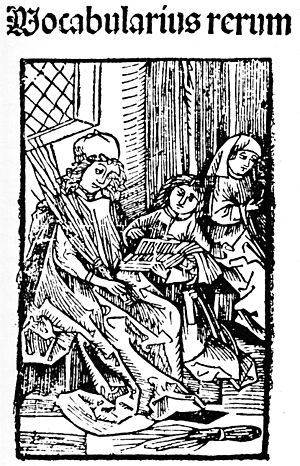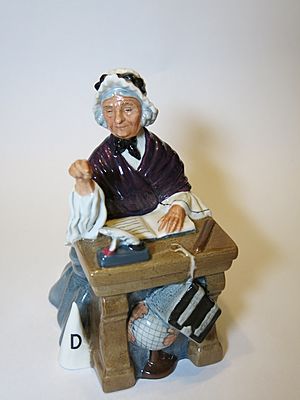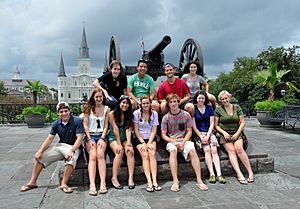Teacher facts for kids
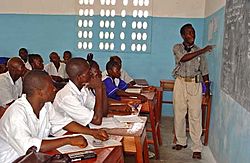
A teacher in a classroom at a secondary school in Pendembu, Sierra Leone.
|
|
| Occupation | |
|---|---|
| Names | Teacher, educator, schoolteacher |
|
Occupation type
|
Profession |
|
Activity sectors
|
Education |
| Description | |
| Competencies | Pedagogy, subject knowledge; competence in teaching the subject, in curriculum, in learner assessment; psychology; planning; leadership. |
|
Education required
|
(varies by country) Teaching certification |
|
Fields of
employment |
Schools |
|
Related jobs
|
Professor, academic, lecturer, tutor |
A teacher is someone who helps students learn new things, gain skills, and understand important values. They are also called schoolteachers or, more formally, educators.
Sometimes, anyone can be a teacher, like when you show a friend how to do something. In some places, young people might learn at home with their family, which is called homeschooling. Other jobs, like a youth worker, also involve a lot of teaching.
Most of the time, professional teachers work in schools to teach students. This article is about people who are paid to teach in a formal setting, like a school.
Contents
What Teachers Do
A teacher's job can be different depending on where they live and the culture.
Teachers might teach students how to read and write (literacy) or work with numbers (numeracy). They can also teach crafts, vocational training (job skills), art, religion, or important life skills.
Formal teaching tasks include planning lessons based on what students need to learn. They also give lessons and check how well students are learning.
Teachers often do more than just teach in the classroom. They might go with students on field trips or help organize school events. They can also supervise after-school activities. In some schools, teachers are also in charge of student discipline.
Skills and Qualities of a Good Teacher
Teaching is a very complex job. It happens in a specific place and time, and it's shaped by the values of that community. What teachers are expected to do can depend on history, what people think education is for, and how we understand learning.
Important Skills
Teachers around the world need different skills, but there are some common ideas about what makes a good teacher:
- A teacher can be seen as someone who manages learning.
- A teacher can be a caring person.
- A teacher can be an expert learner themselves.
- A teacher can be a cultural and community leader.
Experts agree that teachers need three main things:
- Knowledge: This includes knowing their subject well and how to teach it. They also need to understand the school's curriculum, how students learn (psychology), and how to check student progress.
- Practical Skills: These are skills like planning lessons, using teaching tools, managing students, and checking learning.
- Attitudes: These are important values and beliefs, like being committed to helping students.
Good Qualities
Being Enthusiastic
Teachers who show excitement about what they are teaching and about their students can create a great learning experience. These teachers don't just teach by memory; they try to make every lesson interesting. Even if they teach the same things often, enthusiastic teachers try to keep things fresh. Students often rate enthusiastic teachers higher than those who don't show much excitement.

When teachers are enthusiastic, students are more likely to be engaged, interested, and energetic. They become curious about learning the subject. Research shows that teacher enthusiasm can make students more motivated to learn and feel more alive in the classroom.
Enthusiasm can help in many ways. It can create an energetic classroom where students get excited about learning. Enthusiastic teachers might also help students feel more in control of their own learning. When a teacher is excited, students might also "catch" that excitement and become more motivated themselves.
Connecting with Students
Research shows that how students feel about school and how motivated they are is closely linked to their relationships with teachers. Enthusiastic teachers are especially good at building positive connections with their students. Their ability to create good learning environments depends on these relationships.
Good interactions between teachers and students are key to helping students succeed in school and in their personal lives. Teachers should guide students to connect their personal goals with their school goals. Students who have positive teacher interactions often have more self-confidence and greater success.
Students are more likely to connect with teachers who are friendly and supportive. They will also show more interest in classes taught by these teachers. Teachers who spend more time talking and working directly with students are seen as supportive and effective. Good teachers invite students to participate, allow humor in the classroom, and are willing to play.
Becoming a Teacher
In many countries, if you want to become a teacher, you first need to get special professional qualifications from a university or college. These qualifications might include studying pedagogy, which is the science of teaching.
Like other professionals, teachers often continue their education after they qualify. This is called continuing professional development.
The importance of the teaching profession can vary. In some societies, teachers are respected as much as doctors, lawyers, and engineers. In others, the job has a lower status.
Teachers often go to a College of Education to make sure they have the right knowledge and skills. They also learn about the rules of conduct for teachers.
There are many groups that help teachers learn new things and keep their professional standing strong. These groups often work to protect the public by making sure teachers are certified and follow certain standards.
Teaching Around the World

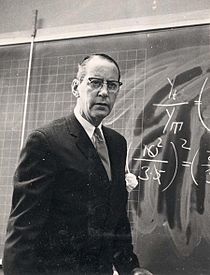
Teachers around the world have many things in common, but also some differences. In almost all countries, teachers go to a university or college. Governments may require a special certification before someone can teach in a school. In many places, especially for elementary school, students might choose an education path in high school. They gain "student-teaching" experience and get a special diploma to start teaching after graduation.
Many schools, especially in the U.S., also require teachers to pass a background check. This is becoming more common in many countries as safety concerns grow.
International schools usually follow a Western curriculum and are for families living in other countries.
Australia
In Australia, education is mostly managed by each state and territory. Education usually has three levels: primary school, then secondary school (high school), and finally tertiary education (universities or colleges).
Canada
To teach in Canada, you need a Bachelor's Degree. In most provinces, you also need a second Bachelor's Degree, like a Bachelor of Education. Teachers can work for public schools, which are funded by the government, or private schools, which get money from private groups.
France
In France, teachers, called professors, are mostly government workers. They are hired through special competitive exams.
Germany
In Germany, teachers are mainly government workers who study in special university programs. There are different types of teachers for elementary schools, middle schools, and high schools.
India
Long ago in India, education often happened in a gurukula. This was a system where students lived with their teacher (guru). The guru did not charge fees, and the community supported the gurukulam. This system was very important until the British arrived.
Today, the role of a teacher in India is clearly defined. There are standards for what a good teacher should know and be able to do. Schools hire teachers directly, and government schools use special tests to find teachers.
Ireland
In Ireland, teachers' salaries depend on their experience and qualifications. Extra pay is given for teaching in the Irish language. Teachers must be registered with the Teaching Council. Since 2006, new teachers also need to have a background check.
Philippines
To become a teacher in the Philippines, you need a bachelor's degree in education. You also need to pass a board exam to get a teaching license from the Professional Regulation Commission.
United Kingdom
Education in the United Kingdom is managed separately by each of its countries.
England
In England, salaries for teachers vary depending on experience and extra duties. Teachers in state schools must have at least a bachelor's degree and complete an approved teacher education program. They also need to be licensed.
Many areas offer different ways to become a teacher, especially for subjects where it's hard to find teachers. There are good job opportunities for teachers, as many are retiring.
Scotland
In Scotland, anyone who wants to teach must be registered with the General Teaching Council for Scotland. Teachers usually complete a special program at a Scottish University. After finishing, they get "Provisional Registration" and then "Full Registration" after a year if they meet the standards.
Teachers in Scotland can join trade unions like the Educational Institute of Scotland.
Wales
Education in Wales is different in some ways from other parts of the UK. For example, many students in Wales learn mostly or entirely in the Welsh language. Learning Welsh is required for all students until age 16.
Teachers in Wales can join trade unions like ATL. There have been concerns about attacks on teachers in Welsh schools.
United States
In the United States, each state sets its own rules for teaching in public schools. Most public school teachers need a bachelor's degree and must be certified by their state. Many charter schools do not require their teachers to be certified.
The Bureau of Labor Statistics estimates that there are many teachers in the U.S. for elementary, middle school, and secondary school.
Teacher salaries have improved in recent years. Teachers with more experience and higher education usually earn more. Salaries can vary a lot depending on the state and the cost of living. For example, wealthy suburban school districts often pay more.
Many teachers earn extra money by supervising after-school programs. Public school teachers often get good benefits, like health insurance. Some schools are also starting to offer merit pay, which gives teachers extra money for excellent teaching or high student test scores. Also, many teachers now sell their lesson plans online to other teachers.
The United Nations has a goal to increase the number of qualified teachers around the world by 2030. This is part of an effort to improve the quality of teaching everywhere.
Assistant Teachers
Assistant teachers help the main teacher, often in the same classroom. There are different types around the world, and their roles can vary.
For example, in Germany, there are Foreign Language Assistants. In the United Kingdom, teaching assistants help teachers and can supervise groups of students. In Japan, there are Assistant Language Teachers in schools.
Learning by teaching is a method where students prepare and teach lessons. The idea is that students learn better when they teach others.
Related pages
Images for kids
-
The teacher-student-monument in Rostock, Germany, honors teachers
See also
 In Spanish: Profesor para niños
In Spanish: Profesor para niños


